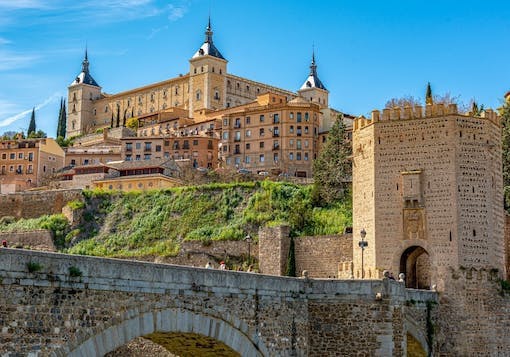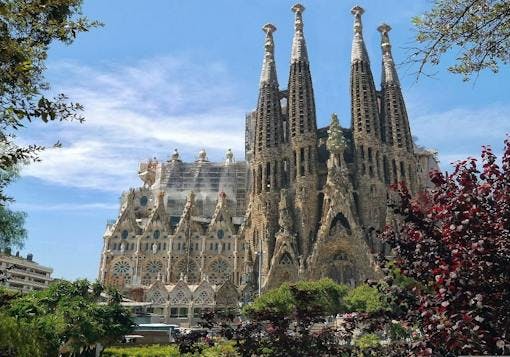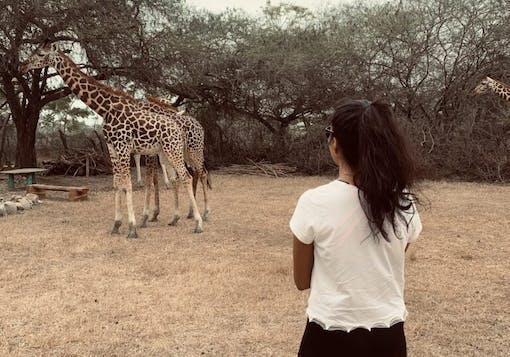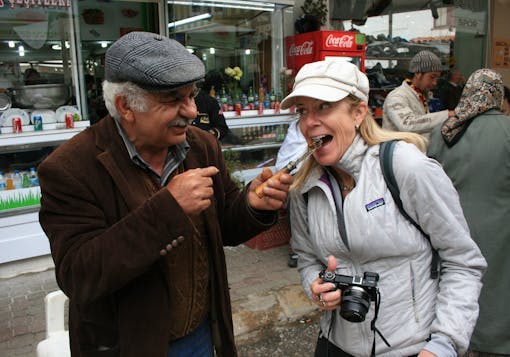Sustainable Tourism & Food: A tasty intersection

28
Apr
Sustainable Tourism & Food: A tasty intersection
Food is a relevant aspect of our lives and a central feature of our travel experience. The good news is that through tourism, we can work towards sustainable development just by focusing on food. Let’s take a look at how food intersects with the economic, social, cultural, and environmental objectives of sustainable development. Let’s also consider the supply chain of food, from local production to travelers’ consumption, and finish by discussing whose ‘responsibility’ it is to ensure that sustainable food and authentic eating experiences are incorporated into tourism and our everyday lives.
Food and the Sustainable Development Goals
There are 17 Sustainable Development Goals (SDGs) laid out by the United Nations, covering important topics from gender equality to life on land and below sea.
As a first step in looking at how food plays into the SDGs and sustainable travel, we suggest reflecting on how food connects with all the dimensions of sustainability and how it can drive local development through tourism.
Although we are fully aware that all the dimensions of sustainability overlap most of the time in reality, let’s look at how they exist in separate silos to focus on the theory of the category.
The Economic Dimension
Tourism can always choose to prioritize local producers and farmers in its supply chain. By doing so, it will create new economic opportunities while enriching the restaurants’ menus with fresh seasonal fruits and vegetables, and free-range meat options. Leveraging seasonal, local, and responsibly grown food also comes with the rewarding aspect of lowering or reducing the restaurant’s – and thereby the traveler’s – carbon footprint.
The Social Dimension
Tourism has the power to create more space for groups of citizens that are usually socially marginalized due to a lack of access and connections.
Food-related activities are a tangible way through which women, for example, can use their skills and traditional knowledge to reach new standards of living. This can include having better access to financing, starting new entrepreneurial careers, bettering their living conditions, and building the foundation of their personal independence.
The Cultural Dimension
Food lies at the center of community life and traditional celebrations usually rotate around specific meals. In this way, we can see how each destination is, in one way or another, a cultural item.
By emphasizing and valuing local gastronomy, tourism is actively supporting the preservation of cultural knowledge and culinary skills that could otherwise go lost. Resisting the pressure of modern times, maintaining an active food culture helps preserve the past and share it with future generations.
The Environmental Dimension
Last but not least, tourism can use food as a tool to preserve biodiversity by concentrating on local and organic production. Tourism can also collaborate with science to nourish the rediscovery of indigenous crops. Moreover, food can positively contribute to climate change issues through a conscious way of producing, packaging, and distributing it in a meaningful way. The hospitality sector can use resources in an intentional way, and be aware of their direct and indirect impacts on the surrounding flora and fauna.
Local Sustainable Production, Global Impact
Food plays a critical role in the health of our planet.
According to Harvard T.H. Chan School of Public Health, agriculture is the largest cause of environmental change. Tourism can contribute to it either with a heavily loaded weight or, on the contrary, taking off unnecessary burdens from the environment.
It is valuable to remember that what happens on a local scale usually has immense repercussions at the global level.
By supporting the responsible local producers, in fact, tourism operators are doing the following:
- Strengthening the economies at the destination level
- Reducing the infamous tourism leakage
- Encouraging and protecting the regional biodiversity
‘Sustainable farming’ is the term used to refer to those practices adopted with the ultimate goal to conserve the environment while reducing its negative impacts on it. This not only includes organic production, free from pesticide and chemical additives, but also crop rotation, low-carbon ways of producing the distributing the food, and responsible usage of water resources, among others.
Tourism can contribute greatly to a positive global impact – by simply focusing on food.
‘Food’ is a very general term, and we should also remember that it also includes other local productions besides the crops, which are most immediately associated with it.
Beyond the animal-based products, like, eggs and dairy, there are other plant-based products that sit on our tables, accompany delicious dishes, and are embedded in recipes.
Olive oil, for example, is one of the most basic ingredients of any gastronomy. However, it is not produced everywhere. Spain holds the world production record, uncontested, followed by Italy and Morocco.
You could support local producers and learn directly from them about olive oil production and regional wine while traveling through Spain from the Iberic peninsula to Catalan’s capital, Barcelona on this sustainable tour of Spain's Highlights.
Food: A Cultural Portal
What better way of learning the culture of the place we are visiting than listening to its food stories?
Through traveling, learning about a culture becomes a fun and engaging exercise that can happen through a variety of sensory experiences.
Discovering the local plates and where the tradition of cooking that dish comes from can take us far away in time.
In Kenya, for example, you can taste the rich history of the land through the varied cuisine. Kenya’s food culture is the resulting fusion of African, Indian, and Arab influences, especially in the coastal region. This tour of Mombasa and Watamu takes travelers beyond the renowned marine national park and reserve and the pristine beaches and introduces visitors to the flavors of fresh seafood accompanied by exotic spicy plates and tropical fruits.
The time of the meal is a special moment in many cultures. The act of sitting at the same table and eating together with the host community members, including your tour guide, creates strong bonds and perfectly embodies the meaning of traveling: sharing and learning different cultures.
Hands-on experiences have become very popular ways of exploring a new culture. Getting lost in the smells of the local street markets before entering the kitchen allows visitors to get incredibly close to the place. In addition, when designed and managed well, the pleasant experience can be seen as a sign of respect and appreciation for visitors’ own way of life. This can help guests have transformational experiences that relate what they experience abroad to their lives back home.
Culture can be unveiled in a variety of ways in tourism, but undoubtedly the slow travel approach is the one that can leave the deepest marks under the skin of the travelers.
There are different ways to create meaningful connections, but time is always a critical factor. Without the time to observe, feel, taste, and assimilate a place, the travel experience risks being reduced to a fast-moving sightseeing image.
Moving at the destination’s pace means adapting to its natural rhythms and flowing with its waves. Only at this pace can you start noticing the small corners and the little hidden gems, of which food is one of the most immediate ways to tune in to a culture and its ancient treasures.
During the Mediterranean Slow Travel Food & Wine tour in Western Türkiye, for example, you will have the time to experience both street food and fine dining, enjoy cooking classes, and visit farmer’s markets. Exploring the culture of this Turkish region through gastronomy and the ancient wine tradition will be accomplished through traveling slowly – never exceeding 45 miles per day – and by encountering the cultural heritage and the living history while strolling in less visited towns.
What Happens After Production & Distribution
The contribution of food to a sustainable tourism model includes – but doesn’t end with – conscious production and low-impact distribution. The way the food is packaged, consumed, and disposed of also factors into the equation.
According to sadly familiar figures from the UN Food Agriculture Organization’s (FAO) 2011 report, roughly a third of total food production, i.e. 1.3 billion tons, goes to waste every year. This frightening picture is getting worse since the amount of food loss and waste is expected to rise by a third by 2030 when, according to other studies, the equivalent of 66 tons per second will be lost or thrown away.
It is evident that the tourism industry is responsible for the creation of a big portion of the problem and conscious reflections on the sector’s responsibilities have luckily started to produce changes in the way the industry operates in recent years.
In any case, the responsibility doesn’t fall exclusively on the tourism industry. From a consumer perspective, tourists still have an important role to play.
We should ask ourselves:
- How much of the food waste we produce when traveling is because restaurants and hotels don’t have effective measures in place to prevent and reduce food waste? For example, does a hotel or restaurant buffet show a sign encouraging guests to take only what they can eat, or not?
- How much of the food waste we produce when traveling is the result of us, as travelers, not making conscious choices? For example, when we see a hotel or restaurant buffet, do we proactively think about not taking more than we can eat? a matter of the limited options we found available,
- If we are responsible consumers at home, are we also practicing good habits when on vacation?
If not, why?
Should we blame only an unresponsible and unresponsive industry, or should we also reflect on the way we treat food consumption, including when we’re on holiday? To drive real change, we need the tourism industry and travelers to do better with their food choices and efforts of waste reduction.
It is not only a matter of what kind of food we consume – indigenous versus exotic, for example – but also how we look at something like a hotel or restaurant buffet. Is it an infinite source of satisfaction to be used without consciousness, or a beautiful canvas of possibilities with a name and provenance, a story, and a future?
When no sustainable options have been openly given by the tourism industry itself, we can always enquire and investigate the matter further. Questioning the status quo can contribute to important pressure that can only benefit the sector and prompt it to better itself and find new solutions.
A Shared Responsibility for Sustainable Tourism & Food
We strongly believe that responsible consumption should be integral to the way we travel. It shouldn’t be considered an add-on exercise reserved for a particular moment of the trip.
We reckon that a sustainable way of thinking should be incorporated into all elements of the journey, from the design stage through beyond the end of the trip. We want to allow the sharing of good practices at the destination level to inspire new considerations in travelers’ minds as well.
One of the best examples of seeing sustainability up close in a laid-back setting is this eco-retreat. You can relax with a glass of wine in rural Portugal while learning about regional wine production and sustainability measures at the retreat center. In addition to unwinding, visitors can also push themselves to try something new or improve skills in hobbies like surfing, yoga, photography, or stone sculpting.
Guests can be connected to our local, responsible partners so they can learn and see firsthand the challenges of being sustainable. They can expand their minds about their own impact as a traveler, see how they help locals – especially in rural tourism – and still have an uncompromisingly wonderful vacation.
We want to conclude by highlighting that when it comes to food, the power of a sustainable, conscious choice is, almost always, available during your tourism experience. Where there are no sustainable options available, a new story can start, recognizing that the sustainability challenge is a constructive collective journey.









